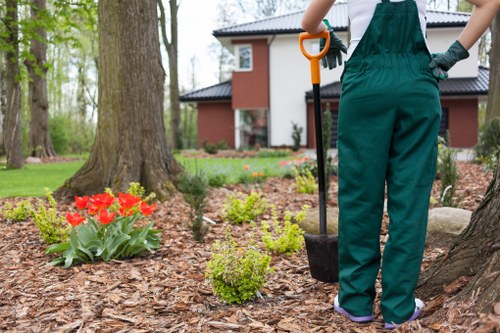Comprehensive Guide to Hedge Trimming in Tree Cutting Services
Introduction to Hedge Trimming

Hedge trimming is an essential aspect of tree cutting services, ensuring that your hedges remain healthy, aesthetically pleasing, and well-maintained. Proper hedge trimming not only enhances the visual appeal of your property but also promotes the overall health of the hedges by removing dead or overgrown branches.
Whether you have a small garden or a large estate, maintaining your hedges requires regular attention and professional expertise. Neglecting hedge trimming can lead to unruly growth, increased pest infestations, and potential damage to nearby structures.
In this article, we will explore the various aspects of hedge trimming within tree cutting services, providing you with valuable insights and tips to keep your hedges in top condition.
Benefits of Professional Hedge Trimming

Hiring professional tree cutting services for hedge trimming offers numerous benefits that go beyond mere aesthetics. Here are some key advantages:
- Enhanced Aesthetics: Professional trimming ensures that your hedges have a uniform shape and size, enhancing the overall look of your property.
- Healthier Hedges: Regular trimming removes dead or diseased branches, promoting healthy growth and preventing the spread of pests and diseases.
- Increased Property Value: Well-maintained hedges can significantly boost the curb appeal and value of your property.
- Safety: Properly trimmed hedges reduce the risk of branches encroaching on pathways, driveways, or structures, ensuring safety for you and your family.
Additionally, professionals have the expertise and tools necessary to handle various types of hedges, ensuring they are trimmed correctly without causing damage.
By investing in professional hedge trimming services, you can enjoy a beautifully landscaped environment that enhances both the functionality and appearance of your outdoor spaces.
Techniques Used in Hedge Trimming

Effective hedge trimming involves more than just cutting back branches. It requires specific techniques to ensure the health and shape of the hedges are maintained. Here are some common techniques used by professionals:
- Shearing: This technique involves using hedge trimmers to create a uniform shape. It is ideal for formal hedges where precision is required.
- Clipping: Clipping is used for less formal hedges, allowing for a more natural shape while still maintaining some level of uniformity.
- Thinning: Thinning involves removing specific branches to reduce density, allowing more light and air to penetrate the hedge, promoting healthier growth.
- Pruning: Pruning focuses on cutting back specific branches to control the size and shape of the hedge, encouraging new growth.
Each of these techniques serves a specific purpose and may be used in combination depending on the type of hedge and the desired outcome. Professionals assess each hedge individually to determine the best approach for trimming.
Proper technique ensures that hedges remain healthy, vibrant, and visually appealing throughout the year.
Tools and Equipment for Hedge Trimming

Using the right tools and equipment is crucial for effective hedge trimming. Professionals typically use a combination of manual and powered tools to achieve the best results. Here are some essential tools used in hedge trimming:
- Hedge Trimmers: Electric or gas-powered trimmers are used for cutting back large areas quickly and efficiently.
- Pruning Shears: For more precise cuts and detailed work, pruning shears are essential.
- Loppers: Loppers are used for cutting thicker branches that hedge trimmers and shears cannot handle.
- Hoes and Rakes: These are used for cleaning up debris and maintaining the area around the hedges.
- Ladders: For taller hedges, ladders or scaffolding may be necessary to reach higher branches safely.
Using high-quality tools not only makes the trimming process more efficient but also ensures that the hedges are not damaged during the process. Professionals are trained to use these tools safely and effectively, minimizing the risk of accidents and ensuring optimal results.
Investing in proper equipment is a key factor in achieving consistent and high-quality hedge trimming outcomes.
Timing and Frequency of Hedge Trimming

Timing is a critical factor in hedge trimming, as it can significantly impact the health and appearance of your hedges. The best time to trim hedges depends on the type of plants and the desired outcome. Here are some general guidelines:
- Spring Trimming: Trimming in early spring encourages new growth and helps shape the hedges before the growing season begins.
- Summer Trimming: Light trimming during summer can help maintain the shape and prevent hedges from becoming overgrown.
- Autumn Trimming: Trimming in autumn prepares the hedges for winter, removing any weak or dead branches that could be damaged by frost.
- Avoid Winter Trimming: In regions with harsh winters, it's best to avoid trimming during this period to prevent stress on the plants.
The frequency of trimming depends on the growth rate of the hedges. Fast-growing hedges may require more frequent trimming, while slower-growing varieties can be maintained with less frequent attention. Generally, hedges should be trimmed at least once or twice a year to maintain their shape and health.
Consulting with a professional can help determine the optimal trimming schedule for your specific types of hedges, ensuring they remain healthy and well-shaped throughout the year.
Common Mistakes in Hedge Trimming

Even with professional services, certain mistakes can occur during hedge trimming that may negatively impact the health and appearance of your hedges. Here are some common mistakes to avoid:
- Over-Trimming: Removing too much of the hedge can stress the plant, making it more susceptible to diseases and pests.
- Improper Shaping: Cutting hedges into unnatural shapes can detract from the aesthetics of your landscape.
- Using Dull Tools: Dull tools can cause jagged cuts, damaging the plant and increasing the risk of infections.
- Trimming at the Wrong Time: Trimming during inappropriate seasons can interfere with the hedge's growth cycle.
- Ignoring Plant Varieties: Different hedge plants have different trimming needs. Treating all hedges the same can lead to suboptimal results.
Avoiding these mistakes requires knowledge, experience, and attention to detail. Professional tree cutting services are trained to recognize and prevent these common errors, ensuring that your hedges remain healthy and visually appealing.
Being aware of these potential pitfalls helps in making informed decisions when maintaining your hedges.
Choosing the Right Hedge Trimming Service

Selecting a reliable and skilled hedge trimming service is crucial for achieving the best results. Here are some factors to consider when choosing a service provider:
- Experience and Expertise: Look for companies with extensive experience in hedge trimming and tree cutting services.
- Reputation: Check reviews, testimonials, and ask for references to gauge the quality of their work.
- Licensing and Insurance: Ensure the company is properly licensed and insured to protect against potential damages or accidents.
- Range of Services: A comprehensive service offering ensures that all your hedge maintenance needs are met.
- Pricing: Compare quotes from different providers, but be cautious of prices that seem too low, as quality may be compromised.
- Customer Service: Responsive and professional customer service is indicative of a reliable company.
Taking the time to research and select the right hedge trimming service can lead to long-term benefits for your property, including beautifully maintained hedges and peace of mind.
Investing in a reputable service ensures that your hedges are in expert hands.
Environmental Benefits of Hedge Trimming

Proper hedge trimming not only benefits your property but also contributes positively to the environment. Here are some environmental advantages:
- Promotes Biodiversity: Healthy hedges provide habitats for various species, enhancing local biodiversity.
- Air Quality Improvement: Well-maintained hedges absorb carbon dioxide and release oxygen, improving air quality.
- Soil Conservation: Trimming helps prevent soil erosion by maintaining the integrity of the hedge structure.
- Water Management: Properly trimmed hedges can aid in water drainage, reducing runoff and preventing waterlogging.
- Climate Regulation: Hedges can act as windbreaks and reduce the impact of extreme weather conditions.
By maintaining your hedges through regular trimming, you contribute to a healthier and more sustainable environment. The ecological balance maintained by healthy hedges plays a significant role in the broader ecosystem.
Emphasizing environmental benefits adds another layer of importance to professional hedge trimming services.
Cost Considerations for Hedge Trimming Services

The cost of hedge trimming services can vary based on several factors. Understanding these factors can help you budget appropriately and ensure you receive value for your investment.
- Size and Density of Hedges: Larger and denser hedges require more time and resources to trim, increasing the cost.
- Type of Hedges: Some hedge plants are more delicate and require specialized care, affecting the overall price.
- Frequency of Service: Regular maintenance contracts may offer discounted rates compared to one-time services.
- Accessibility: Hedges that are difficult to access or located in challenging areas may incur additional charges.
- Additional Services: Services such as disposal of debris, fertilization, or pest control can add to the cost.
While cost is an important consideration, it's essential to balance affordability with quality. Investing in a reputable service may cost more initially but can result in better long-term outcomes for your hedges.
Always obtain multiple quotes and inquire about what is included in the service to make an informed decision.
DIY vs. Professional Hedge Trimming

Deciding between DIY hedge trimming and hiring professionals depends on several factors, including your skill level, the size of the hedges, and the desired outcome. Here are some pros and cons of each approach:
Do-It-Yourself Hedge Trimming
- Pros: Cost-effective, flexible scheduling, personal satisfaction.
- Cons: Requires knowledge and skill, time-consuming, potential for errors or damage.
Professional Hedge Trimming
- Pros: Expertise and experience, high-quality results, time-saving, access to specialized tools.
- Cons: Higher upfront cost, reliance on scheduling.
If you have the necessary skills and equipment, DIY trimming can be a viable option for smaller hedges. However, for larger or more complex hedges, professional services are recommended to ensure optimal results and avoid potential damage.
Ultimately, the choice depends on your specific needs, resources, and the importance you place on achieving professional-quality hedge maintenance.
Safety Considerations in Hedge Trimming

Safety is paramount when it comes to hedge trimming, especially for larger or taller hedges. Here are some key safety considerations:
- Proper Equipment: Using the right tools and personal protective equipment (PPE) reduces the risk of accidents and injuries.
- Training and Expertise: Professionals are trained in safe trimming techniques and aware of potential hazards.
- Stable Platforms: Ensuring ladders or scaffolding are secure prevents falls and other accidents.
- Aware of Surroundings: Being mindful of nearby structures, power lines, and bystanders minimizes risks during trimming.
- Weather Conditions: Avoiding trimming in adverse weather conditions, such as high winds or rain, ensures safer operations.
By prioritizing safety, both DIY enthusiasts and professionals can effectively manage hedge trimming tasks without compromising well-being.
Emphasizing safety measures helps in maintaining a secure and efficient trimming process.
Sustainable Practices in Hedge Trimming

Incorporating sustainable practices into hedge trimming ensures that the environment is respected and resources are used responsibly. Here are some sustainable approaches:
- Using Eco-Friendly Tools: Opt for tools that minimize environmental impact, such as electric trimmers over gas-powered ones.
- Recycling Trimmings: Composting or recycling hedge trimmings reduces waste and benefits the soil.
- Water Conservation: Proper pruning can help hedges conserve water by promoting efficient growth.
- Integrated Pest Management: Using natural pest control methods maintains hedge health without harmful chemicals.
- Minimizing Chemical Use: Reducing or eliminating the use of fertilizers and pesticides promotes a healthier ecosystem.
Adopting these practices not only benefits the environment but also ensures the long-term health and sustainability of your hedges.
Promoting sustainability in hedge trimming aligns your property maintenance with eco-friendly principles.
Conclusion

Hedge trimming is a crucial component of tree cutting services that plays a significant role in maintaining the health, appearance, and functionality of your outdoor spaces. Whether opting for professional services or undertaking the task yourself, understanding the benefits, techniques, tools, and best practices ensures that your hedges remain vibrant and well-maintained.
Investing in regular hedge trimming not only enhances the beauty of your property but also contributes to the overall environmental well-being. By choosing the right service provider and adhering to sustainable and safe practices, you can enjoy the myriad benefits that well-trimmed hedges offer.
Don't wait to transform your landscape—contact us today to schedule your professional hedge trimming service and elevate the beauty of your property.
Frequently Asked Questions

How often should I trim my hedges?
The frequency of hedge trimming depends on the type of hedge and its growth rate. Generally, most hedges benefit from trimming once or twice a year. Fast-growing hedges may require more frequent maintenance to keep them in shape.
Can I trim my hedges myself?
Yes, smaller and less dense hedges can be trimmed by homeowners with the right tools and knowledge. However, for larger or more complex hedges, hiring professionals is recommended to ensure the job is done safely and effectively.
What are the signs that my hedges need trimming?
Signs that your hedges need trimming include overgrown branches, an irregular or unattractive shape, reduced plant health, and encroachment onto pathways or structures. Regular inspections can help determine when trimming is necessary.
What tools are essential for hedge trimming?
Essential tools for hedge trimming include hedge trimmers (electric or gas-powered), pruning shears, loppers, hoes, rakes, and ladders or scaffolding for taller hedges. Using the right tools ensures efficient and effective trimming.
Are there environmental benefits to regular hedge trimming?
Yes, regular hedge trimming promotes healthier plants, which can improve air quality, support biodiversity, prevent soil erosion, and aid in water management. Well-maintained hedges contribute positively to the local ecosystem.
Get Started with Your Hedge Trimming Today

Maintaining your hedges is a vital part of landscape management that enhances both the beauty and functionality of your property. Whether you choose to embark on a DIY project or enlist the help of professional tree cutting services, understanding the intricacies of hedge trimming will ensure you achieve the desired results.
Remember, healthy hedges are a sign of a well-cared-for garden. Regular trimming not only keeps your hedges in shape but also promotes their overall health and longevity.
Ready to transform your outdoor space? Book your service now and experience the difference that expert hedge trimming can make.

